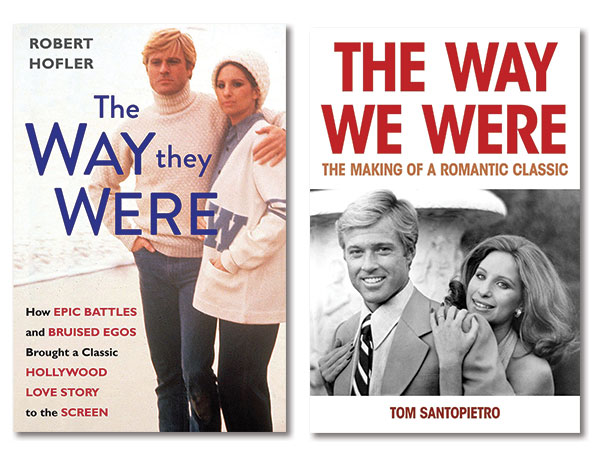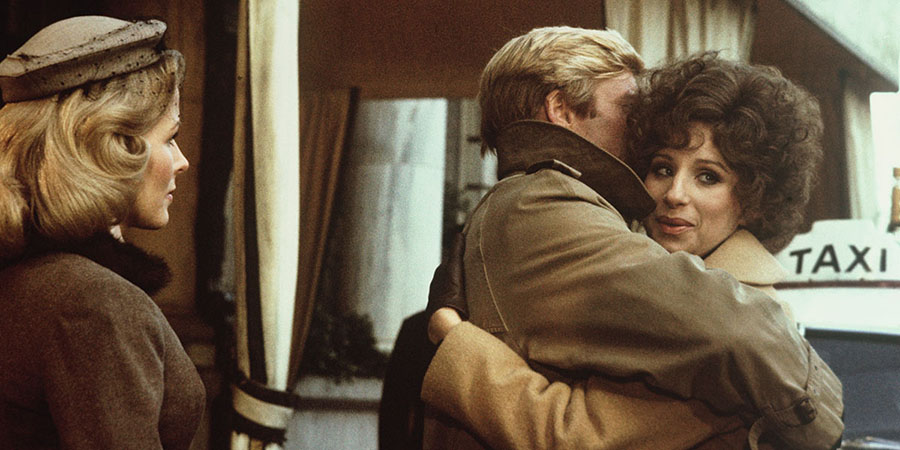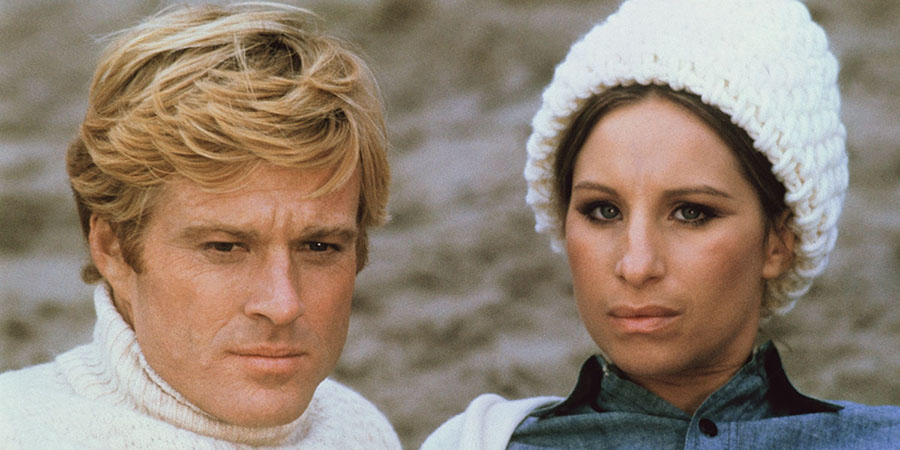‘The Way We Were’: 5 Reasons the Classic Romance Endures 50 Years On

Barbra Streisand and Robert Redford in 'The Way We Were.' The film, which premiered in 1973, is being celebrated with various 50th anniversary events. Photo: Columbia Pictures International/Courtesy of Getty Images
“We lost a lot of innocence in the dark movie palace of our youth,” film critic Rex Reed wrote in a 1973 review of the film The Way We Were. He added that the film, “reclaims it for us. Years from now, in some futuristic movie museum, it just might be one of the movies we’ll be looking at and remembering with fondness.”
The period drama The Way We Were paired superstars Barbra Streisand and Robert Redford as star-crossed lovers. Released in October 1973, it nonetheless proved to be one of the top-grossing movies of the year.
For the uninitiated, the classic love story sees Brooklyn-raised student radical Katie Morosky (Streisand) fall for handsome star athlete Hubbell Gardiner (Redford), a straight-edge WASP who wants to be a writer. Directed by Sydney Pollack, the film takes place in New York and Los Angeles against the political tumult leading up to the Second World War and then during McCarthyism; it stemmed from an original idea by veteran stage and screen writer Arthur Laurents (West Side Story, Rope, Gypsy).
Nostalgia, then, is in the air this Valentine’s Day thanks to the 50th anniversary 4K Blu-ray release of The Way We Were on Feb. 14, as well as screenings this month at the TIFF Bell Lightbox and Fox cinema in Toronto. The film also streams for free on CTV.ca.
In addition, two new books mark the movie’s 50th anniversary year. The Way They Were: How Epic Battles and Bruised Egos Brought a Classic Hollywood Love Story to the Screen by critic Robert Hofler (out now) and showbiz historian Tom Santopietro’s The Way We Were: The Making of a Romantic Classic (out in March). The first looks at the behind-the-scenes drama and the autobiographical aspects, while the latter examines the film itself more closely.
Both authors posit reasons for the movie’s enduring appeal — how it surveys the politics of being an outsider, for example, and the tension between idealism and pragmatism. From its context in social history to that memorable, quietly devastating ending in front of Manhattan’s Plaza Hotel years later, here are five other reasons The Way We Were endures, 50 years on.

The On-Screen Chemistry Is Undeniable
“Superjock Robert Redford, King of the Wasps, meets Superjew Barbra Streisand, Queen of the Yentas, shooting off her mouth for Loyalist Spain and non-intervention,” is how one reviewer at the time encapsulated the contrast between Streisand’s ebullience and Redford’s reticence. The artfully mismatched pair prove that opposites attract. (Unlike, say, Reese Witherspoon and Ashton Kutcher’s awkwardly chilly body language on the recent Your Place or Mine press tour.)
In spite of a decidedly mixed reception from leading critics, the central chemistry between Streisand, now 80, and Redford, now 86, at the height of their fame drives the tearjerker and is undeniable. Both books spend chapters attempting to unpack exactly what created that frisson. For Santopietro, the movie is the ideal interplay between star persona and narrative on screen; he contends that the character of Katie plays like an extension of Streisand herself — both the Brooklyn side and the politically liberal Hollywood superstar.
Streisand was the rare A-list actress who didn’t play down her Jewishness on or off screen, and made it an asset (in their original 1973 review, The Hollywood Reporter singled the movie out for this). Contrast this with Redford’s golden boy next door, perfectly explained by the character’s own Fitzgerald-esque short story read aloud in class. “In a way he was like the country he lived in: everything came too easily to him — but at least he knew it.”

It Tackles a Taboo Subject
The background of Katie and Hubbell’s romantic disintegration is the moral corruption and compromise of the era. Specifically, The Way We Were was the first-ever big picture that dared talk about a dark chapter in recent American politics: the Blacklist that ruined lives and ended careers in Hollywood and beyond. Its effects were still raw and being felt. Laurents’s screenplay channeled his life and beliefs in direct and indirect ways — his experience with the House Un-American Activities Committee, for example, which investigated the motion picture industry as a hotbed of communism. “I believed it wasn’t un-American to be a member of the Communist Party,” he says in Santopietro’s book. “I wanted to say it through a heroine who was a Jewish Communist. In a Hollywood movie.”
In 1973, this social history was still a loaded subject: Hollywood Ten member, screenwriter Dalton Trumbo, wouldn’t officially be recognized with proper credit — or the Oscar statuette he won — for writing Roman Holiday until 1993, another 20 years after The Way We Were. (Incidentally, Hofler’s book documents how Trumbo — along with Paddy Chayefsky and Francis Ford Coppola — were among the writers brought in to beef up Redford’s character.)
Principled Katie is head of the student Young Communists’ League and never loses her passion (years later she calls the maître d’ at an upscale supper club a “fascist rope-holder”). While Katie was partly modelled on a strident acquaintance from his class at Cornell, it’s actually the love story between Laurents and his longtime partner Tom Hatcher, a golden boy similar to Hubbell, which inspired the central relationship.

It Subverts the Traditional Male Gaze
Here is a movie where the man is object of a woman’s blatant desire — for a change. Katie pursues Hubbell and sends openly longing glances his way. (And it’s a tanned and shirtless Redford — getting dressed or running on the beach, that the camera lingers on.) There’s that poignant scene in the apartment when Katie, nervous but thrilled and almost in disbelief, slips into bed with the blond she calls ‘America the beautiful.’ As she reaches an impeccably manicured hand to rake her fingers through his long bangs, the intimate gesture becomes a signature of the film repeated in the bittersweet final scene. Hofler’s book details how, at Streisand’s behest, filming that first sex scene took two days — “take after take with Redford atop her.” The actor wore “two athletic supporters” to protect himself, whereas the actress wore a bikini.
The late Betty White’s crush on Redford was perhaps the most famous, but she wasn’t the only one. Jane Fonda (who co-starred with the actor three times) has talked about how Redford casts a romantic spell, Natalie Wood admittedly fell head over heels while making Inside Daisy Clover, and Meryl Streep has declared him the best on-screen kisser of her career.
Pollack and Laurent are on record about Streisand’s infatuation with the happily married father of four. ”Barbra was delighted because she had a crush on him, even before we started,” Pollack confirmed in the book. “It was hard for women not to have a fixation, because he was everywhere, like Elvis.”
That Theme Song!
It’s a movie unsentimental about how easy it is to be corrupted but, like its theme song, the specific nature of the heartbreak has universal appeal. The box office smash remains memorable thanks to its now-legendary theme and title song, sung by Streisand (of course). The movie’s original score (with its melody frequently heard in key moments throughout the movie) and original song both won Academy Awards. “The Way We Were” isn’t just an earworm: it topped the Billboard charts as the No. 1 pop hit of 1974, and the soundtrack album sold more than two million copies.
It was perhaps most memorably honoured in the final episode of Sex and the City’s second season, when Carrie and the girls discuss why her ex-boyfriend Mr. Big is marrying another woman. (He is, at that very moment, hosting their engagement brunch at The Plaza.) With this news, it dawns on them that Big and Carrie’s impossible love story—about two people who love each other but can’t be together because it’s just too hard—is just like The Way We Were. Specifically, Miranda exclaims: “One word: Hubbell.”
Samantha has somehow never seen it (!) so by way of explanation, she and Charlotte enthusiastically sing a few verses and re-enact iconic moments from the weepie to illustrate how Katie is the archetype of a complicated woman. But it’s more than a nod through dialogue: the episode pays direct homage as Carrie walks home and happens upon Big getting into a car in front of the hotel, just like Streisand and Redford. They share a last rueful exchange (and yes, she does the hair thing) so the finale ends on the same bittersweet note.
It Altered the Course of Streisand’s Career
Not only was it Redford’s first time as a romantic lead, but Streisand has also dished that making the movie was the impetus for her subsequent career choices. Specifically: when director Sydney Pollack cut two scenes from the movie arguably crucial to illustrating why the couple’s relationship disintegrated, as Streisand recalled in a 2017 interview, she was so “horrified” that she resolved to begin directing films herself.
Like co-star Redford (who later ventured behind the camera with acclaimed movies like Ordinary People and A River Runs Through It), Streisand went on to direct Yentl, The Prince of Tides and The Mirror Has Two Faces. She has been one of few female filmmakers in Hollywood with power and influence (she’s still attached to direct a biopic of Catherine the Great in development).
When Zoomer celebrated Streisand’s 80th birthday with this appreciation last April, the icon was also still working on her long-awaited autobiography. This week, her publisher confirmed that the memoir (first announced in 2015!) would be called My Name Is Barbra and was ready at last. It runs more than a thousand pages and will be released this year (Nov. 7). We’re now anxiously awaiting that day, to learn even more about the way it all was.
RELATED:
Barbra Streisand at 80: Celebrating the Legendary Star as the Revival of Funny Girl Hits Broadway